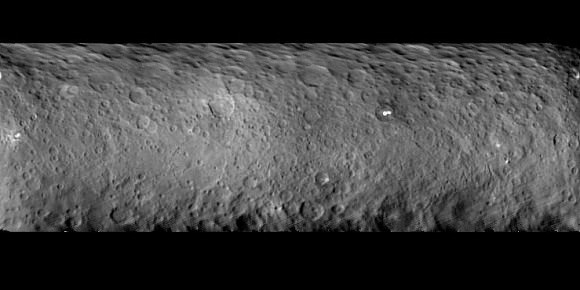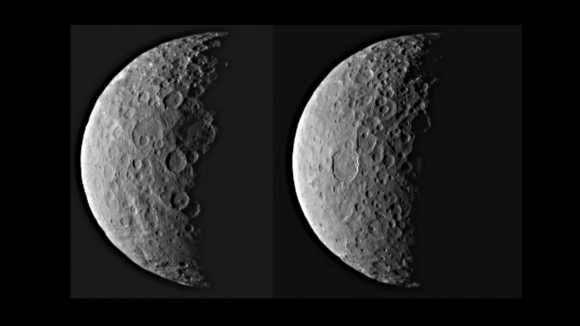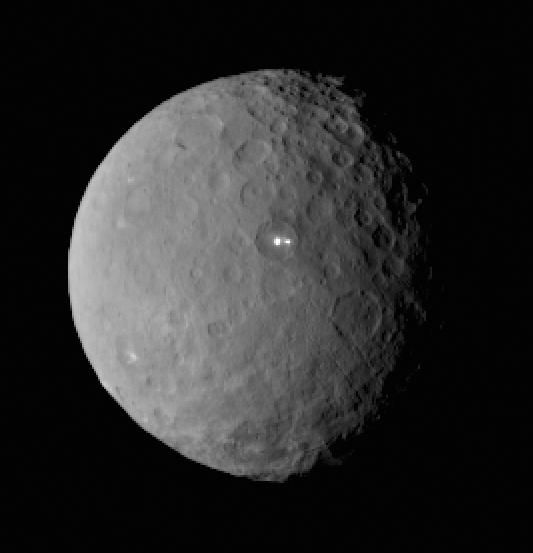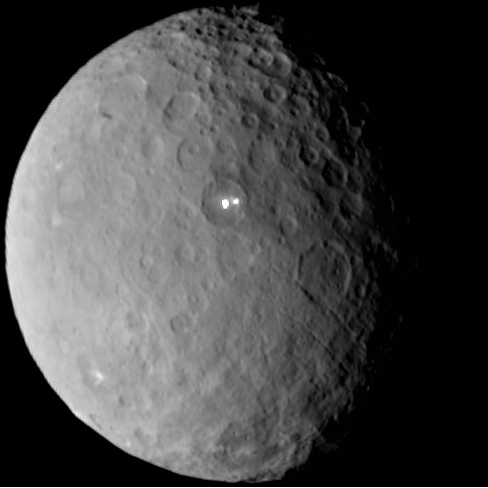As the Dawn spacecraft prepares to enter orbit around Ceres on March 6, the science team provided the latest images and a mission preview during a briefing on March 2. The images released yesterday show more of those unusual bright spots and lots of craters, and feature two new global views of Ceres: one spinning globe, and a mosaic of a flat map-view of Ceres’ surface.
But the most-talked about feature is the 90-km-wide (57-mile) crater with two bright spots.
“These spots are extremely surprising and have been puzzling to the team and everyone that has seen them,” said Deputy Principal Investigator Carol Raymond. “The team is really, really excited about this feature because it is unique in the solar system.”
Raymond added that the team will be revealing the true nature of spots with the public in real time as the spacecraft gets closer and is able to make a determination.
So what is the leading theory on the bright spots?

While cryovolcanoes have been bantered around as a possibility, during the briefing yesterday the science team downplayed that possibility, citing several pieces of evidence.
First, Raymond said the spots are consistent with highly reflective materials that may contain ice or salts. As an example of this, this morning, Cassini imaging lead Carolyn Porco tweeted an image of exposures of bright ice on Saturn’s moon Phoebe.
As ppl ponder the bright spots on #Ceres, remember the exposures of ice we saw on Phoebe http://t.co/r6yikugeqi pic.twitter.com/Bi2vhies8S
— Carolyn Porco (@carolynporco) March 3, 2015
Raymond added that if the bright features end up to be liquid water, salt would be most likely element that would keep the water from freezing. The science team will also be looking for dust levitating from the surface, as sublimating gases could cause dust to rise.
Secondly, Raymond said if the bright spots were a cryovolcano, they would expect to see some type of surface evidence of a mound, peak or crack. “We don’t see that with the bright spots so a cryovolcano is unlikely,” she said.

Third, — and this is also for anyone who may be thinking there is a beam or light-creating mechanism on the surface — team member Chris Russell said there is quite conclusive evidence that the spots are reflecting light, not creating light.
“We have followed the light curve into the terminator,” he said. “The spots do get darker and then go out when the terminator is reached.”
The terminator is the term for the boundary between day and night.
Lastly, even though in 2014 the Herschel spacecraft detected water vapor coming from two longitudal regions on Ceres (one of them is the region where crater with the bright spots is located), the current evidence points to the vaporization or sublimation of ice, not a spewing cryovolcano.
The Herschel team estimated that approximately 6 kg of water vapor is being produced per second, requiring only a tiny fraction of Ceres to be covered by water ice. This links nicely to the two localized surface features that the Herschel team observed and to the bright spots observed by Dawn.
Raymond said the Dawn science team should be able to verify the Herschel emissions, as they have modeled a similar emission coming from a distributed area and they are confident that observations with Dawn’s infrared spectrometer could detect such an emission, if present. “So if the activity is still ongoing, or if it is coming from a deposit left behind, we should be able to detect it,” she said.

After Dawn enters orbit, it will make its first full characterization of Ceres later in April, at an altitude of about 8,400 miles (13,500 kilometers), and it will then spiral down to an altitude of about 2,750 miles (4,430 kilometers), and obtain more science data in its survey science orbit. This phase will last for 22 days, and is designed to obtain a global view of Ceres with Dawn’s framing camera, and global maps with the visible and infrared mapping spectrometer (VIR).
Dawn will then continue to spiral its way down to an altitude of about 920 miles (1,480 kilometers), and in August 2015 will begin a two-month phase known as the high-altitude mapping orbit. During this phase, the spacecraft will continue to acquire near-global maps with the VIR and framing camera at higher resolution than in the survey phase. The spacecraft will also image in “stereo” to resolve the surface in 3-D.
Then, after spiraling down for two months, Dawn will begin its closest orbit around Ceres in late November, at a distance of about 233 miles (375 kilometers), allowing Dawn’s gamma ray and neutron detector (GRaND) and gravity investigation to make their observations.
Dawn’s nominal mission to Ceres is expected to last for 16 months, until near the end of 2016. There is a possibility of an extended mission, but that will depend on the amount of fuel left in the Dawn’s tank. While Dawn’s ion engine is nearly limitless in its power, hydrazine is used for attitude control or pointing the spacecraft – pointing it to Ceres to take images and pointing it back to Earth to send data. Robert Mase, Dawn project manager said the hydrazine the most scarce resource in terms of an extended mission.
“There’s not a likely prospect of years and years ahead of us,” he said.
Jim Green, director of NASA’s Planetary Science Division said while Dawn has plenty of fuel for its nominal mission, it likely won’t last more than a few months in an extended mission.
“We will take stock of how much hydrazine is left and then go through a process of evaluation if we can give the go ahead for an extended mission,” he said. “I’m sure it will observe some really exciting things, but we have to see what the fuel reserves are before we make that decision.”
Still, Dawn will remain in a stable orbit around Ceres for hundreds of years.
See all the latest imagery from Dawn at NASA’s Photojournal page.


I wish someone had asked how much the dark-to-bright range had been stretched (so get a feel for if the bright represents 90% albedo or 45% or what) and if they had any pictures where the white spots were not overexposed.
Now if those bright spots were modulating in terahertz RF that would mean it was an ETI *.relay station…right?
Nods at Mr. Spock…
I wonder if those spots were deliberately overexposed to facilitate media sensationalism. But then again even some “scientists” appear to seriously think there is a woooo woooo factor involved. It’s like they are starting to believe their own sensationalism.
I should expect that there will be a lot of red faces when, as usual, this fiasco turns out to have one of the usual mundane explanations. I expect attention will then return to the “donuts”, “statues”, “flowers” and “fossils” of Mars.
Interesting thought, what if these are ice covered lakes with water beneath the surface? That’s a hypothesis for Mars, that such lakes form occasionally. If so, the water could stay liquid for tens of thousands of years before it freezes solid to the bottom. I think same result would apply to Ceres. Might still be liquid below the surface, or might be that they are frozen solid now but were liquid in the past for many thousand years.
Interesting possible implications for life searches.
For possibilities of ice covered lakes of liquid water on Mars heated by impact, see
https://books.google.co.uk/books?id=2hNsJTfUsmMC&printsec=frontcover#v=snippet&q=heated%20lakes%20years&f=false